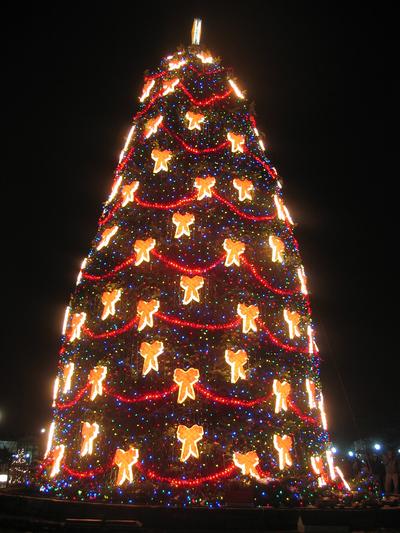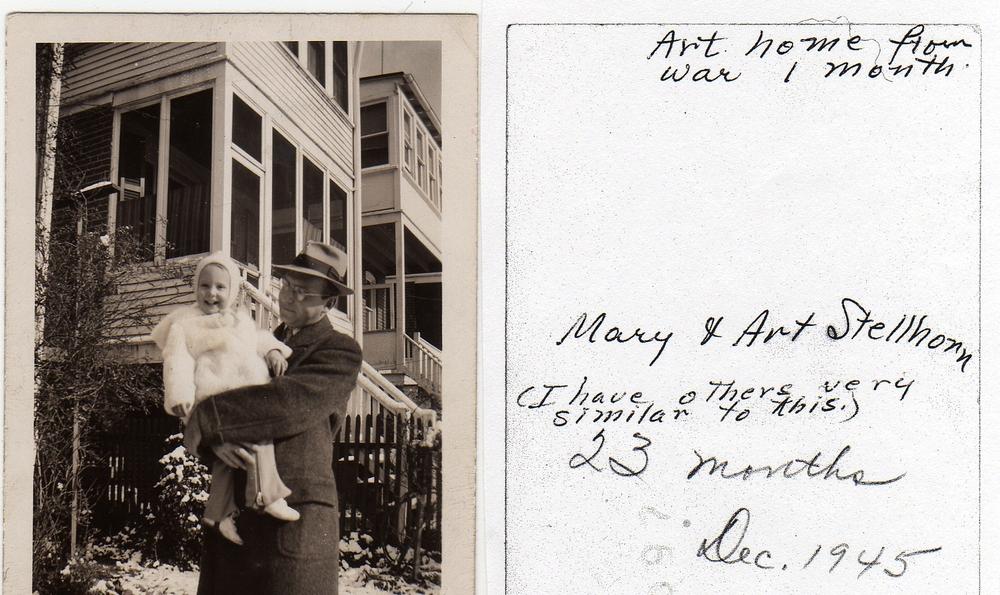Advertisement
Remembering The First Christmas After World War II
Resume
On Christmas Eve 60 years ago today, President Truman touched a button and the National Christmas Tree was ablaze with thousands of red and green lights. The tree had been dark during World War II. But now it was time to celebrate as the U.S. military started to bring as many GI's home as possible.
Matthew Litt reminds us of this history in "Christmas 1945: The Story of the Greatest Celebration in American History," excerpted below.
Were you around for Christmas of 1945? Tell us what you remember, or send us your photos and stories. If you're too young to remember, send us your family's photos.
Listener Mary Stellhorn Roth of Ann Arbor, Mich. sent this photo with her father, who had just returned returned from war.

Listener Barbara Aldrich of Essex Junction, Vermont sent us this letter about her father.
Hello,
I frequently listen to your program and heard your request for memories or family stories of Christmas 1945. You referred to it as possibly the best Christmas ever. It may have been for many families in America, but it must have been a terrible time for many families in Europe and most definitely for my father. He was 17 years old in North Germany (Bremen). He had lost an older brother on the Russian front, his family's apartment building in Bremen had been bombed out. They lost everything.
My father had been trained to fight fires at the docks of Bremerhaven on the North Sea and that is where he was when the war came to an end. He would have joined the Navy had the war continued. He became a prisoner of war under the British. The rest of his family found an abandoned farm house outside of the city and took up residence there until the family who owned the home returned. It was an awkward situation, but they eventually allowed my father's family (father, mother, sister and grandfather) to live in the root cellar. There was hardly any food to be had and they were often hungry.
My father didn't often speak about this time of his life. He came to the United States years later (around 1956) and made his life here. But I know that he and his family suffered in 1945 because of a war they did not choose. They were not Nazis and they did not support Hitler, but they were German and fought for their country just as anyone who fights for his/her country's security and well being. I can only imagine that Christmas 1945 in my father's family was filled with sadness, loss and suffering. I will remember this as my family celebrates the holiday this year.
Merry Christmas and best wishes,
Barbara Aldrich
Author Matthew Litt sent us this newspaper clipping, from the front page of the Nevada State Journal, 12/25/1945.

Christmas 1945: The Story of the Greatest Celebration in American History
By Matthew Litt
President Truman began the nation’s Christmas just seconds after 5:00 p.m., as he was shuffled by Secret Service officers through the crowd gathered on the South Lawn, unanimously anxious for Christmas to begin. This was to be the first tree lighting since December 24, 1941, when President Roosevelt and Prime Minister Churchill led a somber ceremony only seventeen days following the attack on Pearl Harbor. The national tree, like almost all Christmas trees in the United States, remained dark from 1942–1944 to conserve resources for the war. The nearly ten thousand in attendance on the snow-covered grass, and the millions listening from their homes on radio, waited for Truman’s signal that it was once again proper to celebrate Christmas with old-fashioned cheer. Small towns and homes throughout America had their own tree… The President climbed the stairs of the ceremonial platform and acknowledged the crowd with a short smile. The Washington Choral Society sang O’ Come, All Ye Faithful and audience participation was encouraged.
...
The press too, contributed substantially to the great celebration. At the time, information flow was provided by wire connected newspapers that brought homes, communities, and towns together. When the hearts of American citizens were tapped for their intrinsic goodness, it was the newspaper, ever on hand for a good human interest story, that enthusiastically reported it. Numerous streams of affection, love, and “good will toward men” were brought to public attention by the press sharing the nation’s abundant Christmas spirit with its readers. This book is about that special Christmas when reaching out to the less fortunate, the grieving, and the wounded, played a larger role than opening a present under a tree.
Copyright © 2010 by Matthew Litt
Music From This Segment
Music in this piece:
"Hark, The Herald Angels Sing," performed by Ginny Simms
"O, Little Town of Bethlehem," performed by Dinah Shore
"I'll Be Home For Christmas," performed by Bing Crosby
"It Came Upon A Midnight Clear," performed by Judy Garland
"It's Been a Long, Long Time," performed by Bing Crosby
"Hark, The Herald angeles Sing," "O'Little Town of Bethlehem," and "It Came Upon a Midnight Clear" recordings are from a CD called "A Night With The Stars: The 1945 Command Performance Special."
This segment aired on December 24, 2010.